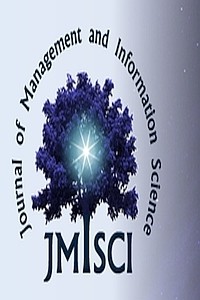Agent-Based Simulation Model for Profit Maximization
Agent-Based Simulation Model for Profit Maximization
___
- Agnetis A. & Pacciarelli D. (2007). Multi-agent single machine scheduling, Ann. Oper. Res. 150 3–15.
- Cheng T.C.E., Ng C.T., & Yuan .J. J. (2006) . Multi-agent scheduling on a single machine to minimize total weighted number of tardy jobs. Theoretical Computer Science 362 273 – 281
- Cheng S.-R. (2014). Scheduling Two-Agents with a Time-Dependent Deterioration to Minimize the Minsum Earliness Measures. Asia Pac. J. Oper. Res., 31, DOI: 10.1142/S0217595914500407
- Cowling P. I., Ouelhadj D. & Petrovic S. (2004). Dynamic scheduling of steel casting and milling using multi-agents. Production Planning & Control, Vol. 15, No. 2, 178–188
- Eren T. (2009). Minimizing the total weighted completion time on a single machine scheduling with release dates and a learning effect. Applied Mathematics and Computation. Vol. 208, Issue 2, pp 355–358
- Huang C.J. & Liao L.M. (2012). A multi-agent-based negotiation approach for parallel machine scheduling with multi-objectives in an electro-etching process, Int. J. Prod. Res. 50 5719–5733.
- Janiak A. & Rudek R. (2008). A new approach to the learning effect: Beyond the learning curve restrictions. Comput. Oper. Res. Volume 35, Issue 11, November pp 3727–3736
- Ji M., He Y.,& Cheng T.C.E. (2007). Single-machine scheduling with periodic maintenance to minimize makespan, Comput. Oper. Res. 34 1764–1770.
- Liao C.J. & Chen W.J.(2003). Single-machine scheduling with periodic maintenance and nonresumable jobs, Comput. Oper. Res. 30 1335–1347
- Madejski, J. (2007). Survey of the agent-based approach to intelligent manufacturing. Journal of Achievements in Materials and Manufacturing Engineering, 21(1), 67–70
- Meirina C., Levchuk G. M., & Pattipati K. R., (2003). A multi-agent decision framework for DDD-III environment,” in Proceedings of the 8th International Command and Control Research and Technology Symposium, June
- Mosheiov, G., & Yovel, U. (2006). Minimizing weighted earliness–tardiness and duedate cost with unit processing-time jobs. European Journal of Operational Research, 172(2), 528–544
- Nong Q. Q., Cheng T. C., & Ng C. T. (2011).Two-agent scheduling to minimize the total cost, European Journal of Operational Research, vol. 215, no. 1, pp. 39–44,
- Ross E. H. P. & Corne D. (2005). Evolutionary Scheduling: A Review, Genetic Programming and Evolvable Machines, 6, 191–220,
- Shaw M.J. & Whinston A.B. (1983). Distributed planning in cellular flexible manufacturing systems, Technical Report, Management Information Research Center, Purdue University,
- Sousa, P., & Ramos, C. (1999). A distributed architecture and negotiation protocol for scheduling in manufacturing systems. Computers in Industry, 38(2), 103–113.
- Walker, S.S., Brennan, R.W., & Norrie, D.H., 2005. Holonic job shop scheduling using a multiagent system. IEEE Intelligent Systems, 20 (1), 50–57.
- Wu C.C., Wu W.-H., Chen J.-C., Yin Y., &Wu W.H. (2013) A study of the single-machine two-agent scheduling problem with release times. Applied Soft Computing Vol. 13, Issue 2, pp 998–1006
- Wooldridge M. & Jennings N. R. (1995). Intelligent Agents: Theory and Practice. In Knowledge Engineering Review 10(2),
- Yin Y., Wu W.-H., Cheng S.-R., Wu C.-C. (2012). An investigation on a two-agent single-machine scheduling problem with unequal release dates Computers and Operations Research, 39 (12) pp. 3062–3073
- Yu X., Zhang Y., Xu D. & Yin Y. (2013). Single machine scheduling problem with two synergetic agents and piece-rate maintenance Applied Mathematical Modelling, 37 (3) pp. 1390–1399
- Zhang L.Q., Lu L.F., & Yuan J.J. (2009). Single machine scheduling with release dates and rejection, Eur. J. Oper. Res. 198 975–978
- Başlangıç: 2013
- Yayıncı: Kerim GÖZTEPE
Agent-Based Simulation Model for Profit Maximization
A Heuristic Approach for Shelf Space Allocation Problem
A. Hande Erol Binguler, Serol Bulkan, Mustafa Agaoğlu
A Short Statistical Analysis of JMISCI Readers Based on Google Analytics Data
Operational Criteria Evaluation for Collaboration of Innovative SMEs
Irem Duzdar, Gülgün Kayakutlu, Bahar Sennaroğlu
Counterinsurgency Policy in Phase IV of Operation Iraqi Freedom
